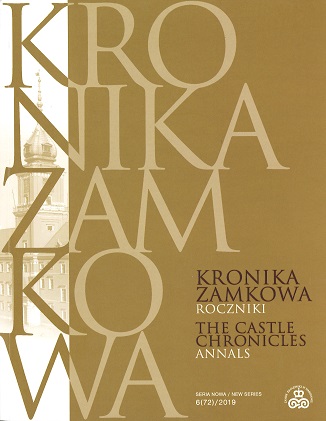Memorabilis ingressus. Architektura efemeryczna na okazję intrady koronacyjnej Konstancji Austriaczki (1605).
Memorabilis ingressus. Ephermeral Architecture Marking Consatnce of Austria's Entry (1605).
Author(s): Jacek ŻukowskiSubject(s): Fine Arts / Performing Arts, History of Art
Published by: Arx Regia® Wydawnictwo Zamku Królewskiego w Warszawie – Muzeum
Keywords: Constance of Austria; Sigismund III; wedding; coronation; Krakow; commemorative architecture; commemorative literature; regalist propaganda
Summary/Abstract: The entry of Sigismund III and Constance of Austria into Krakow in December 1605 was depicted in the famous Stockholm Roll. However, probably as a result of subsequent damage, the work leaves out a number of important elements of the setting of the ceremonial entrance, including ephemeral art objects, the subject matter of this text. After a historical and theoretic introduction, discussing e.g. the role of automatons in the triumphant iconosphere, the author attempts a reconstruction of the visual and poetic setting of the memorable ingress (perforce a sketchy one due to the lack of direct iconographic sources). Intense work led by one “HM painter” (most likely Tommaso Dolabella), supervised by Mikołaj Żelechowski, a councillor of Krakow, began in September. The first ephemeral structure, erected in Kleparz district, with a mobile figure of the White Eagle, its movements accompanied by appropriate music, combined urban propaganda and the apotheosis of a political system (“The Republic bestows this honour upon you”) with a regalist homage, hence the visual references to the groom’s latest military successes. The second triumphal gate, at the exit of Florianska Street, was arranged as an ethical treaty with an extensive emblematic agenda. This was a tribute to the bride’s virtues (she was pronounced the epitome of virtú who, thanks to her proper upbringing, would be able to face the insidious tricks of her enemies), an apotheosis of the alliance of the House of Vasa and the House of Habsburg, and a reference to the king’s opponents, fleeing in the face of his merits, especially his bravery, constancy of choice and genius of governance. One of the compositions heralded a time of trial for hearts and deeds, which might have signalled an imminent coup of the subjects. The third gate, at the start of Grodzka Street, was built at the expense of Sigismund, who certainly played a large part in the development of its ideological agenda. The latter was based on a vision of an alliance with the empire, invariably beneficial for the Republic. Astonishingly, the last structure, erected at the foot of Wawel Castle, looked like a two-part fortress-gate. It featured a sculpted crypto-portrait of the bride depicted as Constance, matched by the figures of Public Happiness, Concord and Peace. An absence of divisions in the state was to provide a remedy for all the ills of public life, while the king’s antagonists were to be dispersed by the light of the wedding torches. Arguably inspired by Seneca’s dialogue De constantia sapientis (On the Firmness of the Wise), the apotheosis of the Jagiellonian and Vasa dynasties attempted also to refute any opposition to the marriage, quite commonly regarded as godless (the king was marrying his sister-in-law).
Journal: Kronika Zamkowa. Roczniki
- Issue Year: 6/2019
- Issue No: 6
- Page Range: 75-100
- Page Count: 26
- Language: Polish

